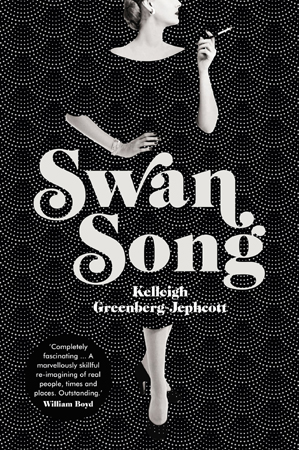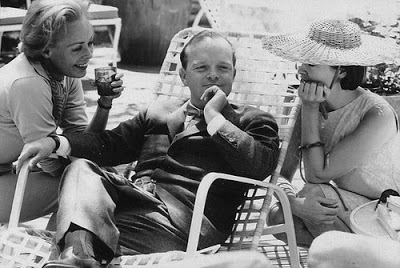I’ve always had very conflicted feelings about Truman Capote. This is the author who wrote the achingly beautiful autobiographical short story ‘A Christmas Memory’ which my cousin read to an enraptured audience every year at his annual Christmas party. And, of course, he penned the novella ‘Breakfast at Tiffany’s’ whose whiff of glamour surrounding Holly Golightly’s tale of self-creation made the teenage me desperate to move to a city. But Capote was also the man who spat venom about countless figures I admire from my favourite author Joyce Carol Oates who he called “a joke monster who ought to be beheaded in a public auditorium” to Meryl Streep who he called “the Creep. Ooh, God, she looks like a chicken.” Many years later, Oates had the last word and proved who really succeeded and endured by tweeting on October 14th 2013: “Ironic that I am a judge for the Truman Capote award when Capote in a druggy interview said he hated me & that I should be executed. LOL.” So I’ve never made the effort to read some of Capote’s most enduring works like “In Cold Blood” and “Music for Chameleons” and certainly not his notorious unfinished novel “Answered Prayers”. But I was thrilled to better come to understand an interpretation and look at Capote’s complex, spirited and ultimately tragic life through reading Kelleigh Greenberg-Jephcott’s novel “Swan Song” about the high-society heroines Capote befriended and shockingly betrayed.
In 1975, Capote published excerpts from his unfinished novel “Answered Prayers” in Esquire which presented thinly veiled portraits of several wealthy, powerful trend-setters and their husbands. He spilled all the tea about their romantic trysts and dirty laundry. These women such as Babe Paley (a style icon), Slim Keith (a socialite credited with discovering Lauren Bacall), Gloria Guinness (a beauty rumoured to have once been a Nazi spy) and Lee Radziwill (Jackie Kennedy’s younger sister) had confided in Capote over the years and made him a firm fixture of their elite circle. He had a charisma, wit and talent for giving people what they needed. Capote sought to immortalize their stories in literature and reveal the sordid truth about their husbands by writing his new novel which he envisioned as a 20th century version of “Remembrance of Things Past”. The women didn’t see it this way and expelled him from their group, turning him into a social outcast. Capote sought to turn these flesh and blood women who he referred to as his “swans” into characters, but Greenberg-Jephcott endeavours to give them their voices and identities back in her novel. It’s narrated from their collective perspective as they observe Capote’s downfall as well as devoting sections to their individual stories. Fascinatingly, the author also includes multiple versions of Capote’s life tailored to appeal to the different women’s personalities. It builds to a complex portrait that raises questions about the difference between fact and fiction, the boundaries between self-creation and self-delusion and the real meaning of love/friendship.
These are all themes threaded throughout Capote’s own work so it’s fascinating the way Greenberg-Jephcott posits how he grappled with these problems within his own life. It also asks what the difference is between drawing upon real life for the sake of art and the degree to which an author exploits those closest to him. Of course, decades after all the dust has settled, almost no one cares about the particulars of these women’s affairs which were once tabloid headlines. If Capote was able to capture something about universal concepts of ambition and betrayal while also describing the particulars of a bygone age of American history his writing would have lasting value. But what responsibility should he have had to respecting his friends’ privacy? And how much was he motivated to write these things as an elaborate revenge upon the high society which shunned his mother and drove her to suicide? Greenberg-Jephcott weaves ideas into her narrative about Capote’s lowly upbringing, the community and family who rejected him and his intense longing for his mother’s approval. It’s fascinating how the author shows Capote to be at once a fragile boy and a vindictive genius in one alcohol/drug-fuelled gluttonous man.
All this is such rich material that it’s almost easy to forget the admirable writing skills Greenberg-Jephcott deploys in bringing this complex story to life. The novel bursts with details about some of the most important figures of the age that these women mingled with – everyone from the Kennedys to Hollywood bigwigs to Diego Rivera to macho blowhards like Ernst Hemingway and Gore Vidal – as well as honouring the admirable accomplishments of the women themselves. There are such evocative descriptions of place from the rural landscape of Capote’s Louisiana upbringing to sun-bleached afternoons on the Italian Riviera to glitzy parties in New York City. The author captures inflections of speech from Southern drawls to society slang. It makes for vivid and mesmerising reading. I was particularly interested in the descriptions of Capote’s relationship to his childhood friend Harper Lee who mostly existed on the periphery of his life but played an important part. In a way, it seems a shame that he didn’t value and cultivate this continuous friendship over the course of his life rather than seek to gain favour with the high society he aspired to join. If he’d sought favour with his intellectual equals rather than needlessly trashing them out of what I can only suppose was jealousy he might have established more stable and enduring friendships. But his example shows how even a genius with great psychological insight can be toppled by the mechanisms of his own ego. He was also the product of a part of American culture that’s relentlessly aspirational and wealth-driven in a way that often leads to bloated excess and dissolution.
The wonderful thing is that “Swan Song” doesn’t read like a tragic tale, but a celebration of beauty and art and intimacy. There is peril, loss and a price to pay, but there’s also an infectious spirit to the many scintillating personalities the author brilliantly portrays that made me want to lean in and listen.










